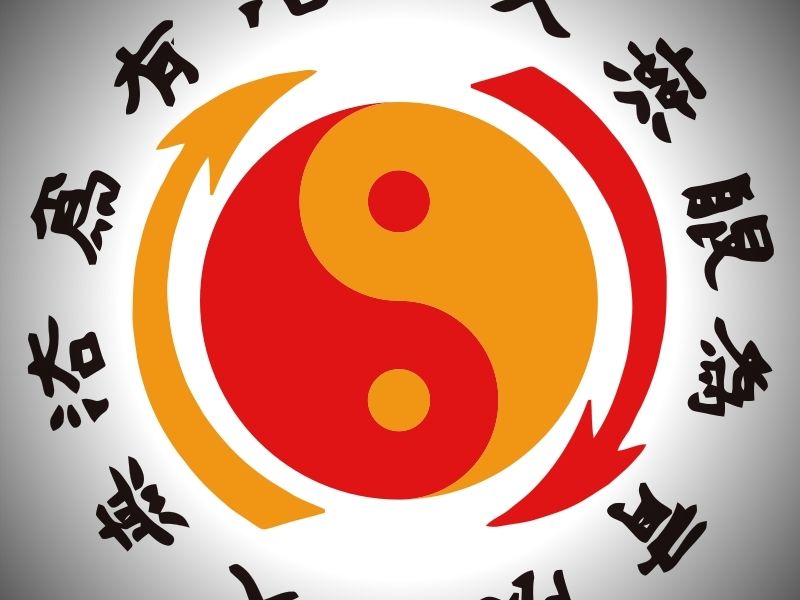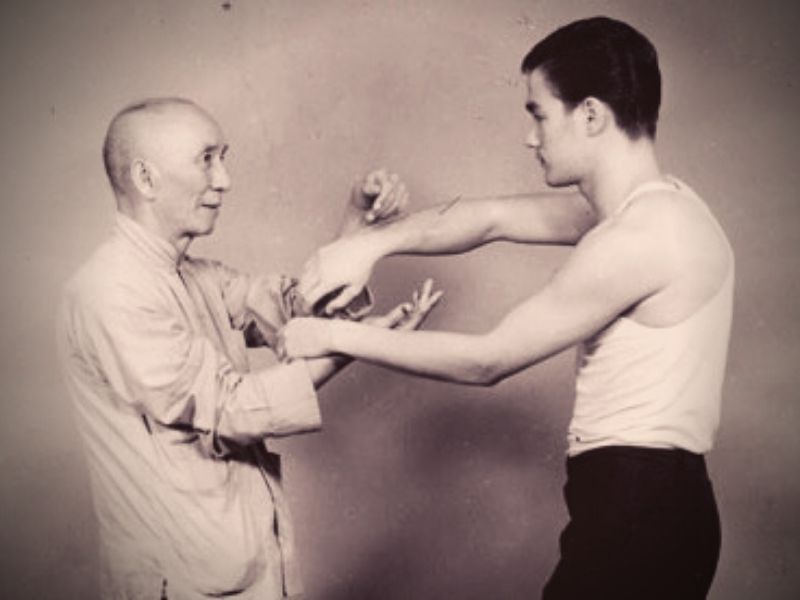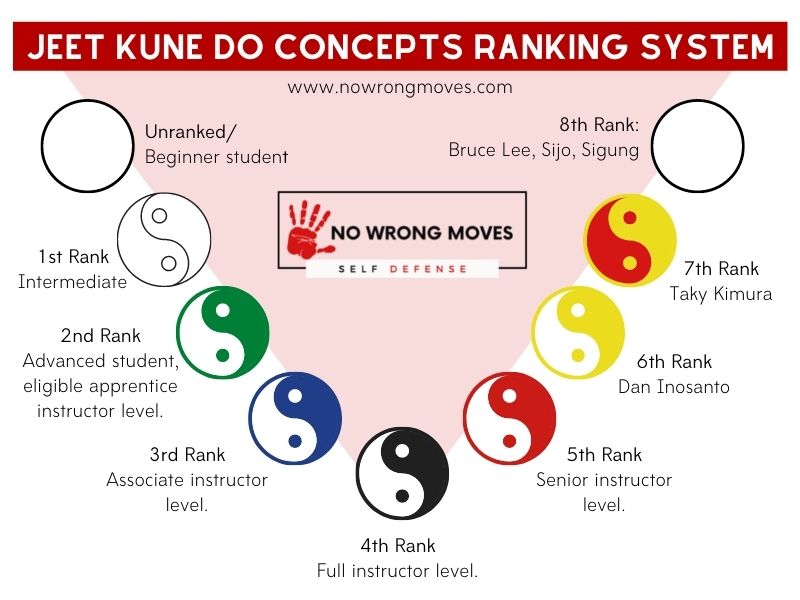
So you want to know more about Jeet Kune Do? Great! In this post, I cover the following;
- What Jeet Kune Do Is
- Where Jeet Kune Do Comes From
- The Benefits of Jeet Kune Do
- How To Get Started In Jeet Kune Do
- What To Expect From Your First Jeet Kune Do Class
- The Different Jeet Kune Do Levels & Ranks
- Why It Is So Important To Find A Good Jeet Kune Do Teacher or Class
Let's get straight into it...
What is Jeet Kune Do

Jeet Kune Do isn't your ordinary martial art. Conceived and practiced by the legendary Bruce Lee, it's an "eclectic martial arts philosophy" that was born from Lee's vast experiences in unarmed fighting and self-defense.
And if that wasn't enough, he also drew inspiration from Eclecticism, Zen Buddhism and Taoism. Talk about a one-of-a-kind mashup!
But what exactly is Jeet Kune Do? It's been described as an "intelligent martial art", and for good reason. It's not just about fighting methods.
Instead, it's all about making the human body learn as much as possible, until it's as fluid, "like water." And once you understand that principle, everything else in the art follows suit.
At the core of Jeet Kune Do is the idea of intercepting your opponent's attack, intercepting their idea of wanting to strike.
It's a set of principles designed to help you make instant judgments and decisions, to improve yourself both physically and mentally, and to respond with the perfect counterattack. In short, it's the ultimate martial art for the quick-witted and lightning-fast!
Where Does Jeet Kune Do Come From?

In the early stages of his martial arts journey, Bruce Lee studied Wing Chun and delved into other forms of fighting. Eventually, he developed a martial art called Jun Fan Gung Fu in 1962.
However, Lee realized the limitations of sticking to systematized martial arts after his encounter with Wong Jack-man in 1964. From that point on, he dedicated himself to refining his approach to martial arts, and in 1965, he introduced the basic concept of Jeet Kune Do.
Lee's philosophy was not about adding more to create a system, but rather, selecting the best elements. He used the Chan Buddhism metaphor of constantly filling and emptying a cup of water to describe his philosophy of "casting off what is useless."
Lee believed that traditional, form-based martial arts were restrictive and ineffective in real self-defense situations. He felt that real combat was dynamic and alive, and it required a different approach.
Jeet Kune Do was designed to be adaptable to the constantly changing nature of combat. Lee believed that decisions about which techniques to use should be made in the context of "real combat" or "all-out sparring."
He thought that only in these situations could practitioners determine which techniques were truly effective and worthy of adoption.
How to get started in Jeet Kune Do: 7 Steps To Mastery!

- Research different Jeet Kune Do schools and find one that aligns with your goals and beliefs.
- Attend a trial class to see if the school and instructors are a good fit for you.
- Begin learning the basic techniques, principles, and forms of Jeet Kune Do under the guidance of a qualified instructor.
- Practice consistently to improve your technique and understanding of Jeet Kune Do principles.
- Continually challenge yourself by attending workshops and seminars, sparring with other practitioners, and seeking new opportunities for growth within the Jeet Kune Do community.
- Watch and study Jeet Kune Do masters to gain inspiration and new insights into the art.
- Always approach your practice with humility and an openness to learning.
What To Expect In Your First Jeet Kune Do Class
At your first Jeet Kune Do class or practice session, be prepared for a vigorous and challenging workout. The class will start with a warm-up, followed by stretching.
Then you'll learn and practice different punches, kicks, and blocks. The class will finish with sparring and conditioning.
The whole workout will last for about 1 1/2 hours. Be prepared to work hard and have a lot of fun! Jeet Kune Do is a great way to get in shape, learn self-defense, and meet new people.
Different Jeet Kune Do Ranks And Levels

In the martial art of Jeet Kune Do, there is a common misconception that there are no belts or ranking system. This likely stems from the fact that belts aren't standardized among JKD schools, and that Bruce Lee himself didn't even give belts to his students.
That doesn't mean ranks don't exist though. Jeet Kune Do does have a belt system--it just isn't as formalized as other martial arts.
The belt system in Jeet Kune Do consists of five levels, each represented by a different colored belt. The first level is the beginner level, represented by a white belt.
The second level is the intermediate level, represented by a green belt. The third level is the advanced level, represented by a brown belt. The fourth level is the expert level, represented by a red belt. Finally, the fifth level represents mastery, represented by a black belt.
In Jeet Kune Do, rank is based on an individual's proficiency in the art rather than the amount of time they have been practicing it.
The ranks are not awarded based on the amount of techniques or forms the practitioner has learned, but rather on their understanding and application of the art. Promotion of rank is at the discretion of the instructor, and is based on their observation of the student's progress and ability.
The Importance of A Good Jeet Kune Do Instructor

Choosing a good Jeet Kune Do teacher is important because they will help you to progress in your martial arts training. A good teacher will have a lot of experience and will be able to pass on their knowledge to you.
They will also be able to give you feedback on your progress and help you to set goals. In addition, a good Jeet Kune Do teacher will be able to motivate you and keep you focused on your training.
Choosing the right Jeet Kune Do teacher can make a big difference in your martial arts journey.
Notable Jeet Kune Do Movies and Figures
Some cool movies with Jeet Kune Do:
- The Way of the Dragon (1972)
- Enter the Dragon (1973)
- Game of Death (1978)
- The Legend of Drunken Master (1994)
And, just in case you wanted to do some more research, here are some notable figures who practice or have practiced JKD
- Bruce Lee, the founder of Jeet Kune Do
- Daniel Inosanto, a martial arts instructor and student of Bruce Lee
- Manny Pacquiao, a professional boxer who incorporates Jeet Kune Do into his fighting style
- Gina Carano, a mixed martial artist and actress known for her use of Jeet Kune Do in fights
- Jean-Claude Van Damme, an actor and martial artist who trained in Jeet Kune Do under Daniel Inosanto
The Wrap-Up

So to sum things up, Jeet Kune Do was created by Bruce Lee, who sought to break away from the traditional confines of martial arts and develop a system that was effective and practical in real-life situations.
Jeet Kune Do's focus on constant self-improvement, fluidity, and adaptability has made it a popular choice for individuals seeking to improve their physical, mental, and emotional well-being.
So if you are ready to take your martial arts journey to the next level, why not give Jeet Kune Do a try? With its practical approach and emphasis on personal growth, it just might be the perfect fit for you.
Check out other martial arts, like Kendo, here!
[author-box-jpx-fitness]
